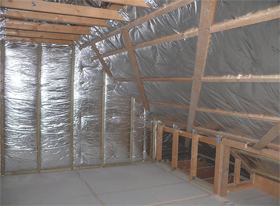The Importance of Multifoil Insulation for Loft Conversions
The Importance of Multifoil Insulation for Loft Conversions
Converting your loft has gained popularity among homeowners in the ever-evolving world of home improvement. This option provides a practical and efficient solution for utilising available space by transforming an idle attic into a functional and cosy room, without the need for extensive construction or relocating. As the demand for loft conversions continues to rise, homeowners are seeking innovative methods to promote energy efficiency and reduce environmental impact. This piece will explore the importance of Multifoil Insulation for loft conversions.

Loft Conversion Insulation
Efficient insulation is a crucial element in a loft conversion, as it has a significant impact on controlling the temperature. In addition to offering thermal insulation, it also contributes to significant energy preservation by decreasing the strain on heating systems.
Previously, loft insulation relied on materials such as fibreglass and mineral wool, which although effective, has drawbacks such as health risks and decreased thermal efficiency over time. However, Multifoil Insulation offers a more innovative alternative that addresses these concerns and offers superior insulation properties.
Additionally, The application of Multifoil Insulation can assist in achieving a U-value of 0.15, which is currently necessary to comply with the current Building Regulations.
The Benefits of Multifoil Insulation
Multifoil Insulation is highly effective as it integrates multiple layers of reflective foil and insulation material. This unique combination creates a barrier that effectively reflects radiant heat, resulting in reduced heat transfer and improved thermal efficiency.
The unique feature of Multifoil Insulation is its reliance on the reflective qualities of foil rather than just trapping air pockets for insulation. This allows it to effectively redirect heat towards its source, thereby regulating the temperature in the loft space.
Here at Multifoil Insulation, we have created the TrioQuilt Roof Insulation 0.15 System by the revised U-value requirement of 0.15 for flat and pitched roofs under the Part L Building Regulations set by the government. This update has made it more difficult to achieve the desired U-value, resulting in increased expenses and a larger area needed for insulation. The Tri0Quilt System has been designed to take up as little room as possible so your loft conversion is as spacious as possible.
Moreover, The TrioQuilt system consists of two layers of YBS SuperQuilt and a layer of EcoLoft Non-Itch. This system can achieve a U-value of 0.15 in most homes, which is required for Building Regulations in the UK from 2022 onwards.
Conclusion
Multifoil Insulation has become a popular choice for loft conversions. Due to the rising need for eco-friendly as well as energy-efficient living alternatives. Its remarkable features of thermal insulation, versatility, and cost-effectiveness make it an attractive option for homeowners who want to maximise their space and minimise their environmental footprint.
